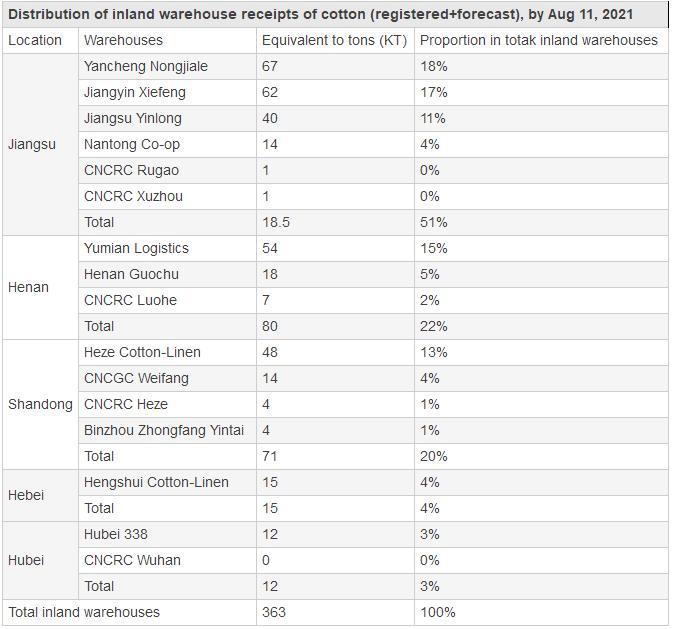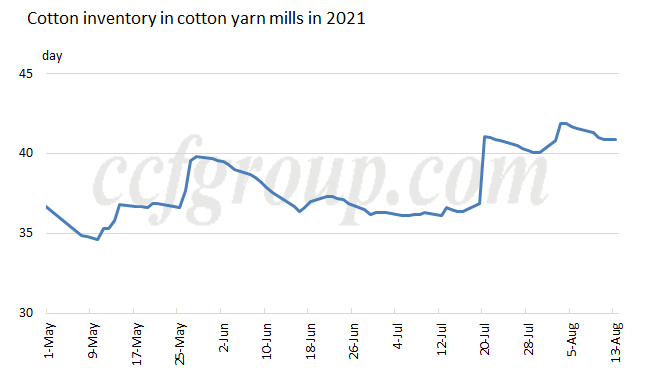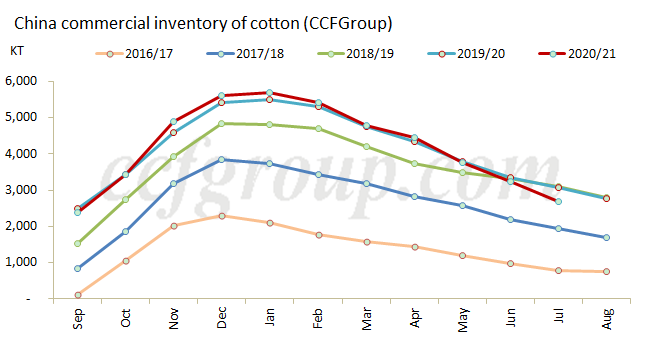Epidemic impacts cotton transportation, and cotton inventory in mills remains tight
Recently, the cotton transportation in Henan, Jiangsu and Xinjiang is restrained somewhat with the increasing new COVID cases, while operating rate of spinning mills remains high, which causes tight supply of cotton. This article analyzes the cotton commercial inventory in Henan, Jiangsu and Xinjiang and the transportation condition, and states the current downstream demand combined with the condition of spinning mills.
For Chinese cotton, the cotton inventory in Xinjiang warehouses takes a higher proportion than that in inland warehouses. Currently, the inventory of warehouse receipts of cotton in Xinjiang (registered + forecast) is about 174kt. The cotton inventory in Xinjiang is mostly non-warehouse cotton, so it cannot be viewed well from the warehouse receipts. The transportation by road is mostly affected in Xinjiang under the strict epidemic control, and cars from the provinces with confirmed cases basically cannot enter Xinjiang, so the transportation by road is almost suspended, but the transportation by railway continues, just the efficiency declines.
In inland provinces, the warehouse receipts of cotton accounts for more than half of the commercial inventory in inland, especially in Jiangsu and Henan warehouses, so warehouse receipts can be viewed to see the cotton liquidity. Due to severe epidemic situation in Jiangsu and Henan, the efficiency of transportation decreases somewhat. The table shows that the warehouse receipts of cotton in Jiangsu and Henan takes a proportion as high as 73% of the total warehouse receipts in inland, especially Jiangsu, the proportion reaches 51%, so the efficient transportation in Jiangsu and Henan has big meaning.

Viewed from the cancellation of warehouse receipts in Jiangsu and Henan recently, though the cancellation speed slows down in Aug, the daily cancelled volumes remain above 500 tons in warehouses of Yancheng Nongjiale, Jiangsu Xiefeng, Jiangsu Yinlong and Yumian, whose remaining inventory is relatively large. As long as it meets the road passing conditions, cotton can still be transported normally. The slower cancellation speed is partly due to heavier looking-on mood of spinning mills with continued upswing of Zhengzhou cotton futures.

Currently, though cotton inventory in spinning mills is relatively high in recent years, with the continual high cotton consumption, the cotton inventory in spinning mills remains slightly tight for spinners. Some spinning mills only have 20-30 days of cotton inventory or even lower. By end July, the yearly decrement of cotton commercial inventory has enlarged obviously, and the commercial inventory includes some imported cotton inventory, so in general, domestic cotton supply remains tight.

Conclusion: the epidemic has restricted the cotton transportation in Xinjiang, Henan and Jiangsu. For Chinese cotton, the cotton inventory in Xinjiang warehouses is higher than that in inland warehouses. The transportation by road in Xinjiang is impacted much, while transportation by railway continues. Viewed from the warehouse receipt cancellation, the cancellation speed in Jiangsu and Henan warehouses slows down somewhat, the daily cancelled volumes remain above 500 tons in warehouses of Yancheng Nongjiale, Jiangsu Xiefeng, Jiangsu Yinlong and Yumian, whose remaining inventory is relatively large. The slower speed is more attributed to the lower buying interests from spinning mills after ZCE cotton futures market rises. Nevertheless, with high cotton consumption, the commercial inventory has reduced much by end July, and the cotton inventory for spinning mills remains tight somewhat.
- Top keywords
- Cotton Price
- Cotton Futures Price
- Cotton Futures
- CZCE
- PTA Futures Price
- Chemical Fiber
- Polyester Prices
- Wool price
- PTA Futures
- Shengze Silk
- China
- Yarn Price
- price
- China Textile City
- Fibre Price
- Benzene Price
- Cotton
- Index
- Cotton Index
- PTA
- fabric price
- NYMEX
- Top 10
- textile industry
- Spot Cotton
- Cotton Yarn
- Polyester Price
- Futures
- PTA Price
- cotton yarn price

